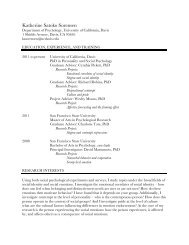The Psychology of Creativity:
The Psychology of Creativity:
The Psychology of Creativity:
Create successful ePaper yourself
Turn your PDF publications into a flip-book with our unique Google optimized e-Paper software.
History <strong>of</strong> <strong>Creativity</strong> Research 14<br />
literary career, an remnants <strong>of</strong> that aspiration would sometimes crop up in his publications. Besides publishing a<br />
utopian novel Walden Two in 1948, he had previously written articles on literary creativity and aesthetics (e.g.,<br />
Skinner, 1939, 1941). Even after the Second World War he would occasionally write something on creativity,<br />
whether in the arts (Skinner, 1972) or the sciences (Skinner, 1956).<br />
This output notwithstanding, Skinner’s writings on creativity was peripheral to his main line <strong>of</strong> research on<br />
operant condition. Consequently, his ideas, unlike those <strong>of</strong>fered by the psychoanalytic and Gestalt schools, did not<br />
penetrate into the creativity literature. <strong>The</strong> only exceptions can be found in the generativity theory <strong>of</strong> creative<br />
insight by Epstein (1990, 1991) and in the experimental work by Eisenberger and his colleagues showing that<br />
creative behavior can be increased through reinforcement (e.g., Eisenberger & Cameron, 1996). But these<br />
extensions take us well into the Post-World War II period.<br />
<strong>The</strong> 20th Century After Post-WW II:<br />
<strong>Creativity</strong> Goes Mainstream<br />
As noted at the beginning <strong>of</strong> this chapter, creativity did not really become a significant topic <strong>of</strong><br />
psychological research until after the Second World War. <strong>The</strong>re are probably several reasons why this was so. In<br />
the first place, despite sporadic military conflicts and economic recessions, the post-war era become an<br />
unprecedented period <strong>of</strong> “peace and prosperity.” In contrast to the preceding era <strong>of</strong> the Great Depression and World<br />
War II, such conditions supported a less dogmatic and open approach to understanding human psychology (Doty,<br />
Peterson, & Winter, 1991; Sales, 1972, 1973). <strong>The</strong> time was definitely over when psychology was dominated by<br />
behaviorists investigating rats running mazes or pigeons pecking at disks. <strong>The</strong> human mind again became a<br />
legitimate topic <strong>of</strong> investigation, a legitimacy that could be extended to creativity as well. In addition, psychology<br />
expanded rapidly as a discipline, increasing the number <strong>of</strong> subfields and venturing into applied areas. Many <strong>of</strong> these<br />
new subdisciplines were highly appreciative <strong>of</strong> creativity as a phenomenon worth serious psychological inquiry.<br />
Finally, psychologists were able to create new measurement strategies and statistical analyses that greatly enhanced<br />
the ability to investigate phenomena as complex and elusive as creativity.<br />
So important were these quantitative advances that I will discuss them first. After that, I will treat three<br />
other movements that made major contributions to creativity research, namely, humanistic psychology, cognitive<br />
science, and evolutionary psychology.
















